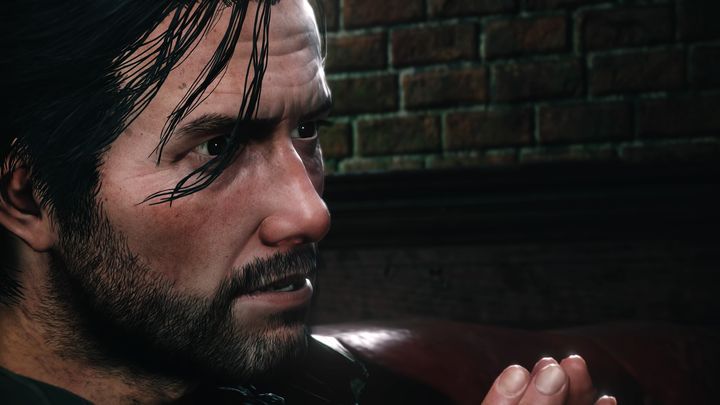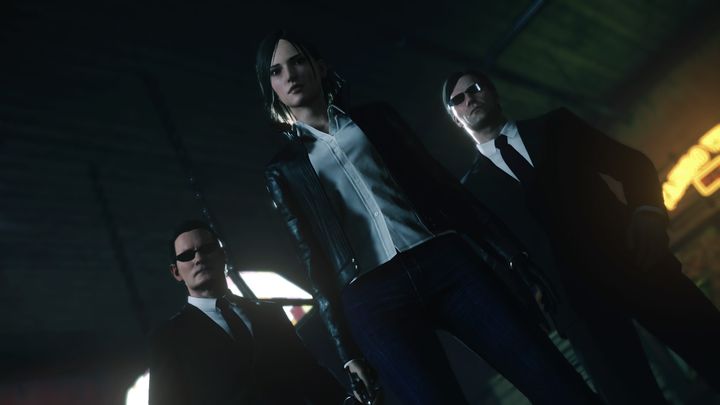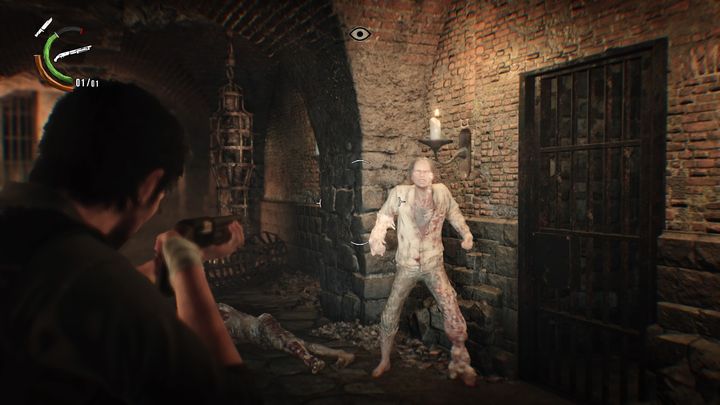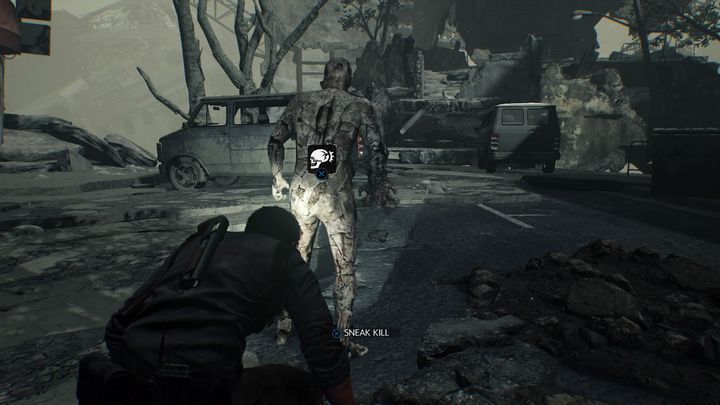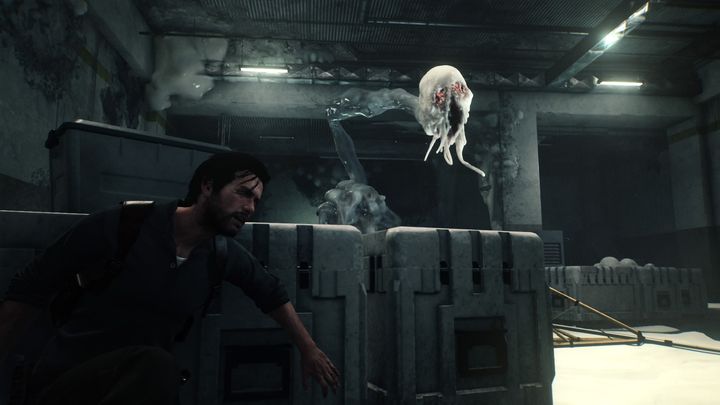At the start of The Evil Within 2, Sebastian Castellanos is definitely not having a good time. Plagued by nightmares involving his missing daughter Lily, he ends up in a bar drowning his sorrows. And while Sebastian is something of a wreck as the start of The Evil Within 2, he is soon approached by former acquaintance Kidman, a sexy female ex-detective who now works for a shady organization known as Mobius.
You see, Mobius is having something of an issue with their STEM system, a machine which is capable of creating a virtual reality world which people who are connected to it can experience as if it were real. The thing is, STEM needs a “core” to function, a person of extraordinary mental ability, and Mobius found the ideal candidate in protagonist Sebastian Castellanos daughter Lily… But apparently Lily has gone missing inside STEM’s virtual world, and former detective Sebastian is drafted by Mobius to locate her, and also to find out what happened to a team of Mobius’ soldiers and specialists who were sent to investigate the matter too.
And if you’re thinking that The Evil Within 2’s plot is convoluted you’re right, and the truth is that the story is not actually up to much, even if it’s told through some impressive cinematic sequences and does borrow some cool ideas from movies like The Matrix and Resident Evil. Of course, the latter is a given taking into account veteran Japanese developer Shinji Mikami is executive producer of this game, and was also behind the first Evil Within game which came out in 2014.
While the game’s story is not up to much, though, The Evil Within 2 does have some superb characters. These include great villains like a psychopath who is fond of art and who has the power to leave his victims stuck at the moment of their deaths in a chilling, slow-motion sequence. There’s also a corrupt priest whom you face in the second half of the game who can control his opponents’ minds, and whose followers wield deadly flamethrowers. Also, the administrator of evil organization Mobius is a good character (and one who bears an uncanny resemblance to the G-man character from classic video game Half-Life 2).
Supporting characters are also pretty great, and an insecure technician name Liam and a Mobius psychologist you meet later on can help out protagonist Sebastian Castellanos in the game’s hostile world, plus you’ll also be in contact with Mobius operative Kidman throughout your adventure.
Protagonist Sebastian himself appears detached and cool throughout the story, even though he’s facing all manner of grotesque creatures and difficult situations, which would leave other people in tatters for sure… Yet he makes remarks like “what the hell is this?” after a brush with death, and remains stoic throughout, something which might make him a horrible character in your book, but I still found him to be a pretty good protagonist all the same.
Overall, The Evil Within 2 does make up for its weak story with a great cast of characters, which you will get to know more about as you play through this survival horror adventure.
As you would expect from a game produced by Shinji Mikami, this is a gruelling experience from beginning to end, and developer Tango Gameworks sure has succeeded at creating an atmosphere of dread and constant danger throughout the game.
Actually, I never really felt powerful in The Evil Within 2, even though you can make use of a wide variety of weaponry while playing as protagonist Sebastian Castellanos (you do get to play as another character near the end though). The arsenal of weapons on offer includes the standard pistol, a nice touch being the fact that Sebastian’s trusty gun remains useful until the very end (tip: stock up on pistol ammo for the final boss fight). You can also make use of a shotgun throughout the game, which makes a satisfying thump sound when shooting, and became my favourite weapon throughout the game.
And making a return from the first Evil Within is the crossbow, which has several bolt types available for it. These act as proximity mines that stick to surfaces, and explode when enemies come close, freezing, electrocuting or doing fire damage to them, although one bolt type can be shot directly at enemies too. The crossbow is meant to add strategic options to the game’s combat, but in practice I found it clumsy to use and had more fun with the other weapons on offer.
Either way, it’s clear this is not meant to be played as a straight shooter. For starters, its takes a lot of ammo to kill enemies, and even the game’s lower-level enemies (a zombie-like creature) are very hard to put down, so going for the stealth option sure is advised here.
It’s a good thing, then, that it’s possible to perform a stealth kill on zombies and other enemies in the game, using Sebastian’s trusty knife to put them out of their misery before they even know you’re there… It’s even possible to finish off a flamethrower-wielding boss in this way too, which sure is satisfying.
Other, more powerful enemies cannot be dealt with in this manner, plus sometimes when my attempt at a sneak kill failed I would end up being spotted by a group of zombies and was forced to run away.
Thankfully, the game has a well-implemented stealth system which will help you avoid unwanted attention. Whenever you’re sneaking about in The Evil Within 2, an eye icon will appear at the top centre of the screen indicating whether enemies can see you or are searching for you, and also whether you are being heard or not.
It’s a system that works well and definitely adds tension to The Evil Within 2’s gameplay, although other aspects of the game’s stealth gameplay don’t work so well. I was rarely able to distract enemies by throwing bottles to the ground, for instance, The Evil Within 2’s enemies seemingly not having a fine sense of hearing.
Also, I constantly found myself turning off the flashlight, even though the game reminded me enemies in The Evil Within 2’s world are not sensitive to light (I found it hard to shake the feeling that I would be easier to spot walking around with my flashlight on though).
Thankfully, the game lets you take a break from its gruelling survival horror gameplay by taking refuge in one of several safe houses interspersed throughout the map. Amongst other things, you can save your game here. The game also autosaves at certain points and during boss fights, although on some occasions I felt slightly frustrated at having to reach a safe house in order to save when I wished to take a break from the game.
Safe houses also contain workshops at which you will be able to craft ammunition and upgrade your weapons. And the game does boast a nuanced crafting system that lets you make new ammunition and healing syringes by using materials like gunpowder and herbs respectively, while the weapon parts you pick up during your journey can be used to upgrade your arsenal of guns, making a weapon like the shotgun more powerful and increasing its rate of fire, for instance.
Aside from crafting and weapon upgrades, you can also look into mirrors at some locations and enter a virtual reality version of protagonist Sebastian’s detective office. Amongst other things, there you will find a wheelchair lying around, and by sitting on it you’ll have access to a screen which allows you to upgrade Sebastian’s skills by using “green gel”, which you can collect from the corpses of fallen zombies and other enemies.
By using green gel you can make Sebastian tougher in a fight by adding points to his life bar, make him sneakier by reducing the sound he makes when walking, or make his shooting more accurate. You can also acquire special abilities like one which makes Sebastian smash bottles on enemies’ heads automatically in order to shake them off when they grab you instead of having to move the gamepad thumbstick frantically from side to side, an upgrade you’ll likely be going for pretty soon in the game.
Overall, the game offers many options to upgrade your character and fine tune the experience by investing more in upgrading one weapon or another, and crafting ammo for one weapon type at the expense of another, something you’ll have no choice but to do as resources are extremely limited in the game.
Actually, I found myself running out of ammo more often then not, and making each bullet count if of paramount importance in order to get through some of the game’s toughest encounters. And the truth is that the game is quite difficult even at the normal difficulty level (which is aptly named survivor). Actually, The Evil Within 2 is a gruelling, tense experience that might leave you exhausted by the end, and not as much fun as I expected overall.
It’s not only that ammo and other resources are very scarce in the game’s world (meaning you’ll find yourself running away from monsters instead of fighting them on many occasions) but this is a quite a slow-paced game overall. Actually, The Evil Within 2 is often more about inaction than action, and remaining hidden observing enemy movements while waiting for the opportunity to strike is a better course of action than charging head on here.
This is particularly true in the game’s stealth-only sections. In these sections the game switches to a first-person view and you’ll have to evade enemies in order to reach your objectives. These are even more slow-paced than the rest of the game, and I did find these slightly tedious to play through truth be told.
Also, the game’s bosses can take you out easily if you don’t resort to evasive manoeuvres, and one in particular has a teleport ability and an annoying knife attack that might make you want to throw your controller in frustration.
And the truth is that making it through many of the game’s encounters is often an exercise in frustration, often making me feel progression was more a matter of trial and error than skill.
It’s clear, then, that those who are into kinetic, fast-paced shooters like Call of Duty won’t dig The Evil Within 2, although hardcore survival horror fans will certainly enjoy Shinji Mikami’s latest take on the genre.
The game does have other things going for it, like its stunning graphics. And graphically-speaking The Evil Within 2 truly shines on the PS4 (which is the version I played through for this review). Not only does the game boast impressive lightning, featuring incredible use of light and shadows, detailed textures and life-like characters, but the art design is pretty great too.
You will see plenty of grotesque imagery throughout the game (such as paintings covered in blood and corpses hanging from ceilings, for instance), plus The Evil Within 2’s story will take you to a variety of beautifully-designed locations and environments including hospitals, decrepit warehouses, ornate mansions and a subterranean environment that might very well be the developers’ vision of hell.
The monsters you face in The Evil Within 2 are also a standout for a survival horror game. These include a hideous creature which appears to be composed of white gel and has bright red eyes, another monstrosity made from parts of human corpses which wields a huge chainsaw, has multiple heads and follows you while laughing with contempt. Others are quite weird, like a four-legged creature with a photo camera for a head which can walk on ceilings.
It’s a pity, though, that fighting these creatures isn’t as much fun as you can imagine due to the limited ammo, sometimes trial and error gameplay and the fact that taking the stealth route isn’t always a viable option in some encounters.
Plus, these are some AI issues at some point in the game when you have a partner tagging along and you enter stealth mode. Enemies were unable to detect my ally, even though she was out in the open while I was hidden (the game only seemed to take into account whether the player character was visible or not), something that hurts immersion quite a bit.
Other minor, immersion-breaking details include the fact that the game seems to be forcing you through a predetermined path most the time, and you’ll only be able to open the doors the game’s designers want you to open, while others remain locked for some mysterious reason… Also, there’s no explanation why protagonist Sebastian is able to destroy certain crates (which contain goodies like ammo and crafting components) and others not.
All things considered, though, this is one game that fans of pure survival horror games and of the first Evil Within game will likely want to pick up, while those who crave fast-paced action and power fantasies in video games might want to exercise caution and decide whether they’re in for a slow-paced, sometimes frustrating and quite difficult horror game. But those that do will find The Evil Within 2 does have its charms, even if it’s clear that the survival horror experience it offers isn’t for everyone.
The Evil Within 2
Score: 70 / 100
Available on: PS4 | Xbox One | PC
Reviewed on: PS4
Publisher: Bethesda Softworks
Launch date: October 13, 2017

